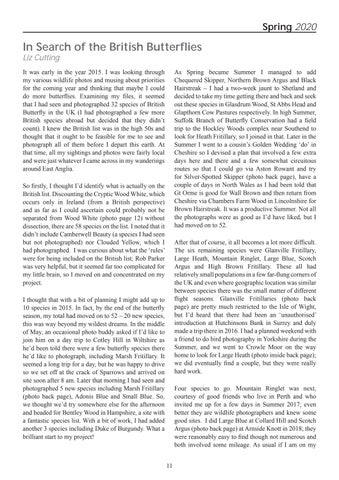Spring 2020
In Search of the British Butterflies Liz Cutting
It was early in the year 2015. I was looking through my various wildlife photos and musing about priorities for the coming year and thinking that maybe I could do more butterflies. Examining my files, it seemed that I had seen and photographed 32 species of British Butterfly in the UK (I had photographed a few more British species abroad but decided that they didn’t count). I knew the British list was in the high 50s and thought that it ought to be feasible for me to see and photograph all of them before I depart this earth. At that time, all my sightings and photos were fairly local and were just whatever I came across in my wanderings around East Anglia.
As Spring became Summer I managed to add Chequered Skipper, Northern Brown Argus and Black Hairstreak – I had a two-week jaunt to Shetland and decided to take my time getting there and back and seek out these species in Glasdrum Wood, St Abbs Head and Glapthorn Cow Pastures respectively. In high Summer, Suffolk Branch of Butterfly Conservation had a field trip to the Hockley Woods complex near Southend to look for Heath Fritillary, so I joined in that. Later in the Summer I went to a cousin’s Golden Wedding ‘do’ in Cheshire so I devised a plan that involved a few extra days here and there and a few somewhat circuitous routes so that I could go via Aston Rowant and try for Silver-Spotted Skipper (photo back page), have a couple of days in North Wales as I had been told that Gt Orme is good for Wall Brown and then return from Cheshire via Chambers Farm Wood in Lincolnshire for Brown Hairstreak. It was a productive Summer. Not all the photographs were as good as I’d have liked, but I had moved on to 52.
So firstly, I thought I’d identify what is actually on the British list. Discounting the Cryptic Wood White, which occurs only in Ireland (from a British perspective) and as far as I could ascertain could probably not be separated from Wood White (photo page 12) without dissection, there are 58 species on the list. I noted that it didn’t include Camberwell Beauty (a species I had seen but not photographed) nor Clouded Yellow, which I had photographed. I was curious about what the ‘rules’ were for being included on the British list; Rob Parker was very helpful, but it seemed far too complicated for my little brain, so I moved on and concentrated on my project.
After that of course, it all becomes a lot more difficult. The six remaining species were Glanville Fritillary, Large Heath, Mountain Ringlet, Large Blue, Scotch Argus and High Brown Fritillary. These all had relatively small populations in a few far-flung corners of the UK and even where geographic location was similar between species there was the small matter of different flight seasons. Glanville Fritillaries (photo back page) are pretty much restricted to the Isle of Wight, but I’d heard that there had been an ‘unauthorised’ introduction at Hutchinsons Bank in Surrey and duly made a trip there in 2016. I had a planned weekend with a friend to do bird photography in Yorkshire during the Summer, and we went to Crowle Moor on the way home to look for Large Heath (photo inside back page); we did eventually find a couple, but they were really hard work.
I thought that with a bit of planning I might add up to 10 species in 2015. In fact, by the end of the butterfly season, my total had moved on to 52 – 20 new species, this was way beyond my wildest dreams. In the middle of May, an occasional photo buddy asked if I’d like to join him on a day trip to Cotley Hill in Wiltshire as he’d been told there were a few butterfly species there he’d like to photograph, including Marsh Fritillary. It seemed a long trip for a day, but he was happy to drive so we set off at the crack of Sparrows and arrived on site soon after 8 am. Later that morning I had seen and photographed 5 new species including Marsh Fritillary (photo back page), Adonis Blue and Small Blue. So, we thought we’d try somewhere else for the afternoon and headed for Bentley Wood in Hampshire, a site with a fantastic species list. With a bit of work, I had added another 3 species including Duke of Burgundy. What a brilliant start to my project!
Four species to go. Mountain Ringlet was next, courtesy of good friends who live in Perth and who invited me up for a few days in Summer 2017; even better they are wildlife photographers and knew some good sites. I did Large Blue at Collard Hill and Scotch Argus (photo back page) at Arnside Knott in 2018; they were reasonably easy to find though not numerous and both involved some mileage. As usual if I am on my 11









